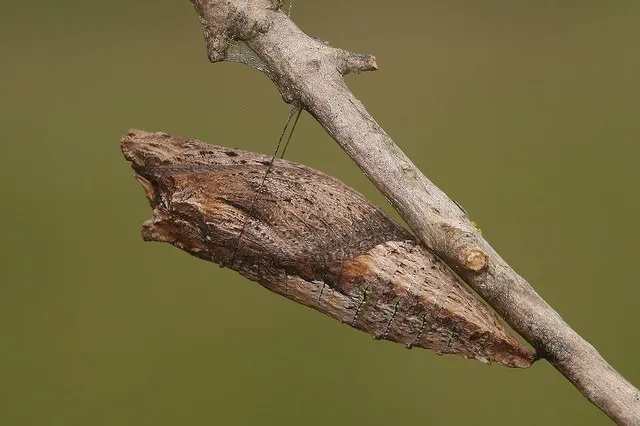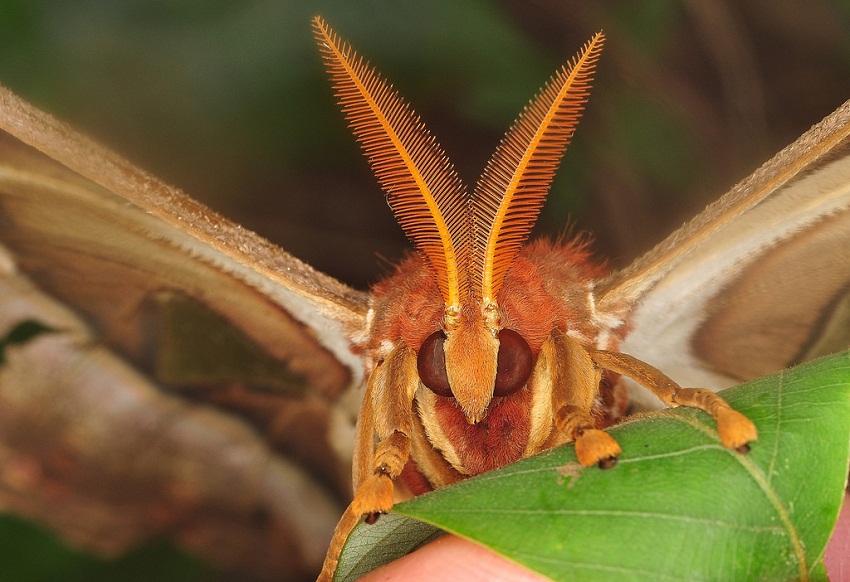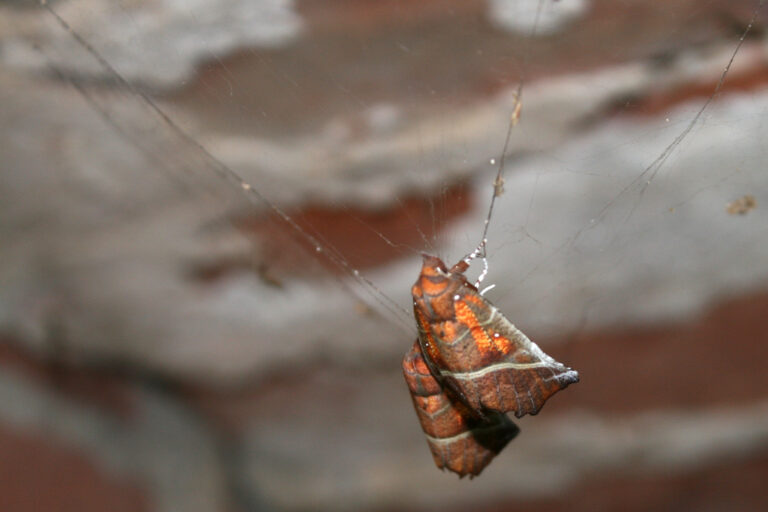Moths do not hibernate like mammals do but employ a strategy called diapause, where their development temporarily halts.
During this time, moths may become less active and seek shelter to survive cold weather. Some moth species overwinter as pupae or larvae, depending on their life cycle.
In addition, this allows them to endure adverse conditions and conserve energy until more favorable temperatures return.
How do moths enter diapause?
Diapause is a physiological state of dormancy that many insects, including moths, enter in response to environmental cues.
During diapause, moths undergo a series of metabolic and physiological changes that allow them to endure unfavorable conditions.
This state can be triggered by factors like changes in temperature, day length, or food availability.
How Diapause Differs from Hibernation:
Diapause is distinct from hibernation, primarily because insects and mammals have fundamentally different biological mechanisms. Hibernation in mammals involves a regulated drop in body temperature, significantly reduced metabolic activity, and a prolonged period of torpor.
In contrast, diapause in moths and insects doesn’t necessarily involve a decrease in body temperature.
Instead, it involves a slowdown in metabolic processes and development.
Moths in diapause can still move and respond to stimuli, although their activity levels are reduced.
Moth Behavior During Diapause

Moths in diapause often seek out sheltered or protected locations to minimize exposure to harsh environmental conditions. They might hide in cracks, crevices, leaf litter, or other secure spots, depending on the species.
During diapause, moths are less active, conserving energy and minimizing resource consumption.
Purpose of Diapause for Moths
The primary purpose of diapause for moths is to ensure their survival during unfavorable periods. Diapause allows moths to synchronize their life cycle with more favorable conditions for growth and reproduction.
By entering diapause, moths can avoid expending energy and resources when they would be less likely to find suitable food or face environmental stressors. Moreover, diapause also helps moths evade predators and adverse weather conditions, increasing their chances of successfully reproducing in the future when conditions are more favorable.
What are the examples of moth species that overwinter as pupae?
These strategies are essential for their survival and successful reproduction in fluctuating and challenging environments.
Moths Overwintering as Pupae:
Examples of Moth Species that Overwinter as Pupae: One well-known example is the Luna moth (Actias luna), which overwinters in the pupal stage. The Cecropia moth (Hyalophora cecropia) is another species that employs this strategy.Pupal overwintering is common among many silk moth species.
Description of Pupal Overwintering Process: Moths that overwinter as pupae spin a cocoon or create a protective silk enclosure around themselves.
Inside the cocoon, the pupa remains in a state of dormancy, with reduced metabolic activity.
Furthermore this pupal stage serves as a shield against cold temperatures, predators, and adverse weather conditions.
In addition, it allows the moth to wait out the winter and emerge as an adult when environmental conditions are more favorable in the spring or summer.
Moths Overwintering as Larvae
The Woolly bear caterpillar (Pyrrharctia isabella) is a famous example of a moth larva that overwinters.
Some tiger moths, like the Yellow wooly bear (Spilosoma virginica), also overwinter in the larval stage.
Description of Larval Overwintering Process
Moths that overwinter as larvae often enter a state of diapause. They typically seek protected locations, such as leaf litter, soil, or the base of plants, where they can avoid
extreme cold and predators.
During diapause, the larva’s metabolic processes slow down, and they become less active.
They might have antifreeze-like chemicals in their bodies to prevent freezing during cold spells.
In the spring, these larvae resume feeding and complete their development into pupae and eventually adults.
How Moths Find Shelter During Adverse Conditions?
Moths exhibit various strategies to find shelter during adverse conditions. They may use their senses to detect changes in temperature, light, or humidity that signal the onset of unfavorable weather.
Some moths are known to migrate to lower altitudes or move to protected microhabitats to escape cold temperatures.
Others rely on their innate instincts to seek out hiding places, like cracks in rocks or tree bark, crevices, or dense vegetation.
Importance of Shelter for Moth Survival:
Shelter is crucial for moth survival during harsh weather conditions. It helps them conserve energy, avoid predation, and prevent desiccation or freezing.
Finding suitable shelter ensures that moths can remain in a state of dormancy or diapause until conditions improve, allowing them to resume their life cycle successfully.
Without shelter, many moths would be vulnerable to the adverse effects of cold, wind, and predators, which could significantly reduce their chances of survival and reproduction.
How do moths contrast with mammals in winter survival?

When it comes to survival in harsh winter conditions, moths and mammals have fundamentally different physiological mechanisms. Mammalian hibernation involves a profound drop in metabolic rate and body temperature, often accompanied by periods of torpor, where the animal becomes nearly inactive. This allows mammals to conserve energy during cold months when food is scarce.
In contrast, moths, as ectothermic insects, lack the ability to enter such a deep state of hibernation. They remain active at higher body temperatures and cannot experience true torpor.
Instead, moths rely on external factors, such as seeking shelter and slowing their metabolic processes through diapause, to endure adverse winter conditions.
Understanding these physiological distinctions is crucial for appreciating the diverse strategies employed by different species to survive in cold environments.
The unique adaptations of moths for surviving adverse conditions
Moths have evolved a range of unique adaptations that enable them to survive adverse conditions, particularly during the winter months. One key adaptation is their ability to enter diapause, a form of dormancy where their development temporarily halts.
During diapause, moths become less active and may seek shelter in protected areas to shield themselves from extreme cold. This period allows them to conserve energy and endure until conditions become more favorable.
Additionally, some moth species have specific overwintering strategies, like spending the winter as pupae or larvae. This strategy helps them avoid the harshest conditions and ensures their survival until spring.
Understanding these unique adaptations provides valuable insights into the resilience and survival strategies of moths, which vary among species and contribute to their ecological success in diverse environments.
FAQ’s
How do you know if a butterfly is hibernating?
Butterflies typically do not hibernate; they undergo a different process called overwintering as pupae or eggs.
Are moths scared of light?
No, moths are not inherently scared of light, but they are often attracted to artificial light sources, which can disrupt their natural behavior.
Can moths see in the dark?
Moths have good night vision and can see in low-light conditions, but they do not see well in complete darkness.
Is light bad for moths?
Artificial lights can be harmful to moths because they can become disoriented and exhausted when they are attracted to bright sources, leading to negative effects on their survival and reproduction.
How long do most moths live?
The lifespan of moths varies by species, but most adult moths typically live for several weeks to a few months.
What do moths symbolize?
Moths symbolize various things in different cultures and contexts, including transformation, determination, and attraction to the unseen or mysterious.
What do moth eggs look like?
Moth eggs come in various shapes and sizes, depending on the species. They are typically small and round or oval, often resembling tiny beads or capsules.
What color is a typical moth?
Moth colors vary widely among species, but they can be brown, gray, white, or various other colors and patterns that help them blend into their natural surroundings.
Conclusion
In summary, moths have their unique ways of coping with harsh conditions, especially during winter, although they don’t hibernate like mammals.
They use diapause, which is like a temporary rest period, to slow down their development and activity. This helps them save energy until the weather gets better.
In addition, Moths also have different tricks, like becoming pupae or larvae during the winter, depending on their species. These strategies are not the same as how mammals hibernate, but they show how moths adapt and survive in nature’s challenges.
Understanding these differences helps us see how amazing moths are at thriving in different environments.

